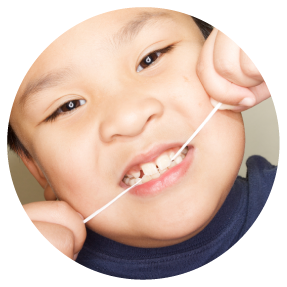
After completing their dental degree, pediatric dentists undergo another two-three years of specialized training to learn how to effectively manage healthy children and children with special needs. A pediatric dentist has the qualifications and the skill to deliver a holistic, child-centric approach to dentistry that is in the best interest of the child.
The American Academy of Pediatric Dentistry recommends a child’s first dental visit occur by one year of age. The first visit allows the dentist to spot early signs of tooth decay and to answer any questions caregivers may have about their children’s oral health.
Book a dental visit for your child once every six months or, based on individual risks or needs, more frequently if required. If an oral health problem is detected during a visit, the dentist may schedule your child’s next appointment sooner.
To prevent bite problems, it is recommended that a child stops using a pacifier by two years of age.
Most children have the coordination to brush effectively by six years old, but they may still need assistance with the more challenging task of flossing. Supervise your child’s brushing technique to determine if he or she is ready to give brushing a go on their own.
Instead of awkward long pieces of dental string, use non-disposable “Y” shape floss holder. These plastic holders make it easy to floss children’s, especially difficult to reach back teeth. Simply place a small piece of floss into the holder and begin. Or make flossing even easier by choose disposable floss picks with dental floss already attached.
As soon as a child’s teeth touch – i.e. floss sticks a little when you slide it between two of your child’s teeth – then flossing should begin – usually around two years of age for most children. Children at this age are too young to floss on their own and will require your help to remove bacteria and plaque through flossing.
Sealants are an extra layer of protection between your child’s teeth and cavities. The sealant is essentially a plastic coating applied to your child’s teeth. Discuss your options with your pediatric dentist to determine if your child can benefit from sealant application.
- Brush and floss regularly using proper techniques.
- Eat a well-balanced diet, low in sugar and acid.
- Schedule regular dental check-ups every six months, or more often if need.
Ensure your child makes a habit of always wearing any protective gear, including:
- A mouth guard – talk to your dentist about making a customized mouth guard for your child
- A helmet – to absorb impact to the head
- Eyewear – for preventing accidental hits in the face from losing the ball in the sun
- A face shield – to avoid damage to facial skin or bones
